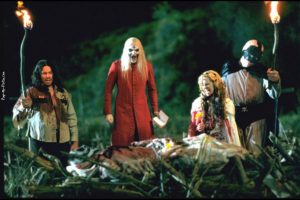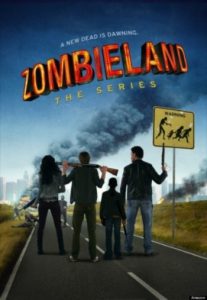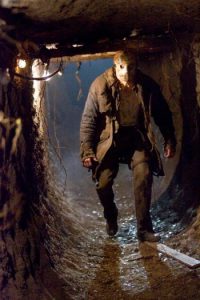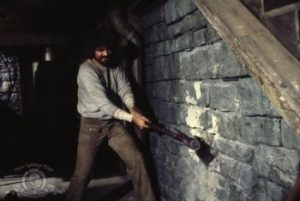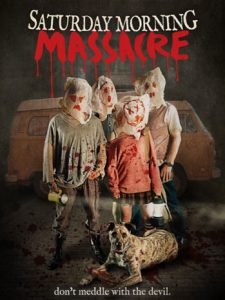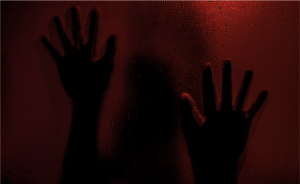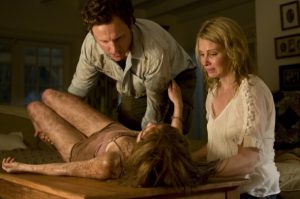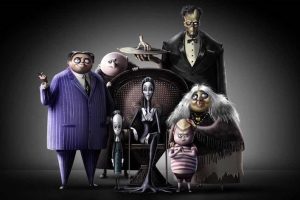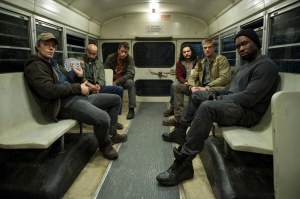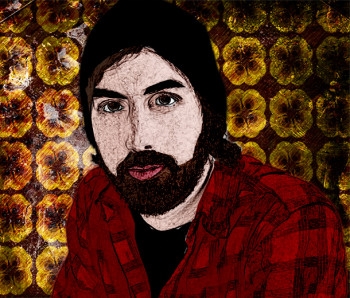
Horror Spotlight: Next Wave’s Ti West
Horror can be a visually audacious and experimental genre. It is the one type of film that you can truly say all bets are off. Unfortunately, for every great original concept there are a flood of cash-grabbing imitators released by distribution companies. – Ti West at CHIFF horror panel.
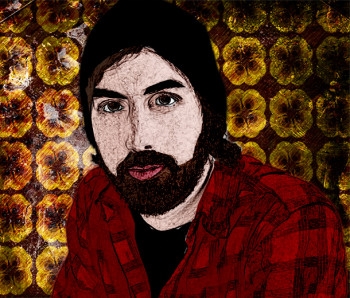 Ti West has often said in interviews that he has no interest in ever repeating himself. While the films he creates differ vastly in their subject matter, they are all of a similar style. West is a modern horror auteur. Between his three larger films: House Of The Devil (2009), The Innkeepers (2011), and The Sacrament (2013) we see the slow-burn plotline as an emerging pattern. He restrains himself from “rushing to the kill” which is effective in building tension. This plot device – also known as a pressure cooker – is not new but feels out of place in current horror cinema.
Ti West has often said in interviews that he has no interest in ever repeating himself. While the films he creates differ vastly in their subject matter, they are all of a similar style. West is a modern horror auteur. Between his three larger films: House Of The Devil (2009), The Innkeepers (2011), and The Sacrament (2013) we see the slow-burn plotline as an emerging pattern. He restrains himself from “rushing to the kill” which is effective in building tension. This plot device – also known as a pressure cooker – is not new but feels out of place in current horror cinema.
One of the best past examples of this kind of narrative occurred in Tobe Hooper’s Texas Chainsaw Massacre (1974). In TCM, we learn from the opening credits that the teens will die, and we spend forty-five minutes anticipating the inevitable. We build a blood lust, and knowing their fate, we are unable to create a close relationship with them. They are heifers for the slaughter. In West’s films we can have preconceived notions of the character’s fate, but normally we are steered in a different direction entirely. He builds the tension while creating a deeper bond between the audience and characters. By the end of West’s films we are invested. Though we’re aware something terrible lays in wait, we root wholeheartedly for the casts survival.
Ti West graduated from film school with an award-winning short that became his calling card. The Wicked clocks in at five minutes. Those minutes mixed with a chance encounter with Larry Fessenden began West’s career. Fessenden was looking to produce a few no-budget films and asked if West would be interested. He told him he was not only interested, but had a script ready to go. West had nothing, but went home and pounded out a script over the course of three days. The first idea West gave Fessenden was not what he was looking for. In turn, West blurted out something about vampire bats, and Fessenden was hooked. As the story goes, West had never consciously thought about vampires or bats for a film, but once Fessenden approved he shot out another screenplay.
The Roost may be the most different from the rest of West’s oeuvre. West has publicly stated many times that he’s against the MTV style editing that became commonplace during the nineties. I completely agree. There are a few cases were it works to the film’s advantage like in Requiem For A Dream, or other films that utilize quick cutting for substance rather than style. The Roost may not feature music video editing, but there is a svengoolie who is hosting the film we are watching. This provides us a framework that allows us to understand The Roost as a love letter to the schlocky films of yesteryear. While the horror host is a campy attribute, it instantly calls up the term homage which West tries to shy away from. As a counterpoint, Rob Zombie embraces the term. House Of A 1,000 Corpses is a perfect representation of MTV editing that highlights style over matter.
After The Roost, Fessenden continued to produce West’s films (Trigger Man, House Of The Devil, and The Innkeepers). Trigger Man (2007) was a complete change of pace from The Roost. Trigger Man actually makes The Roost feel like a thrill-a-minute action film. This is not an insult, instead between these two experiences West learned the balancing act of the slow burn concept.
In Trigger Man, we follow three New York friends who decide to go on a male bonding trip into the woods. They get drunk and shoot at animals, but while they’re reminiscing, a mysterious sniper makes them his target. With a slowly paced and unconventional narrative, West’s influences become transparent. The film would fit nicely in the Dogme-95 movement, while mixing in elements of Gus Van Sant’s death trilogy (Gerry, Elephant, and Last Days). Trigger Man was inspired by a true story, and during the film’s climax Ti West and his star Reggie Cunningham were nearly shot by police. There is a voyeuristic sense to the film which adds another layer of realism to the events. This realism continues through West’s work.
West’s next film provided him a large budget to work with, but ultimately was taken out of his hands. Cabin Fever 2: Spring Break was rife with problems, the biggest of which was studio interference. Although Eli Roth has a producer’s credit, it was the financial institution backing the film that had final cut. Once West witnessed his butchered vision, he tried to take his name off the project. He wanted the common pseudonym of Alan Smithee to replace his name, but the studio would not allow it. Cabin Fever 2 works as a sort of Grad school for West’s progression as a filmmaker. His lesson this time was that to have creative control he would have to continue resorting to micro-budgets for his projects. Immediately after the debacle with the studio, he threw himself into House Of The Devil, which became his claim to fame.
West worked with Fessenden and Glass Eye Pix, who only asked him to stay within budget. If he brought the film in at or under budget he could have carte blanche. The House Of The Devil is often cited as a throwback to the 80′s, but it was simply a horror film set in the 80′s. There are certain genre tropes present such as the creaky old house, the babysitter in peril, the prophet of doom, satanic panic, but these elements combine to create something completely new. The House Of The Devil showcases a brilliant use of restraint on West’s part. The film’s slow pace builds a relentless tension with every beat. While the end may be quick to the finish, it resonates long after your viewing.
2009 was a productive year for West. While making Cabin Fever 2 and House of the Devil, he found time to work with Joe Swanberg in his short film Birthday Suit. West also created a series for IFC entitled Dead And Lonely.
In 2011 West released The Innkeepers which was filmed at The Yankee Pedlar – the same hotel the cast and crew stayed in while making House Of The Devil. The Innkeepers works as a geeky love story and haunted house film. Even though West places his film in the realm of the supernatural, the performances, pacing, and dialogue help to develop his two characters into multifaceted people. Claire and Luke are characters we can invest ourselves in. This is how the tension begins – we like them and don’t want anything to happen to them. Again, there is a great pay-off to the film, but it takes a backseat to the atmosphere and tension that precede it. There is a certain fairytale-like loss of innocence that occurs during the film.
The Innkeepers shows a beautiful hotel that is under financial strain and will be forced to close. In many ways this situation mirrors a lot of West’s feelings toward corporate America and independent endeavors. Because of corporate entities like Holiday Inn, places like the Pedlar become more difficult to keep open. The same analogy can be used in regards to the film industry. Studios with large scale productions destroy the indies. When you look at the films playing at your multiplex, they are usually the big budget popcorn movies. The independent films are playing arthouse theaters that are normally only located in major cities. Rural America could drive the distance to see the indies or go up the block and see a superhero movie instead. Luckily, independent film has new platforms for media consumers, but digital download is still a far cry from a non-limited theatrical release.
When West was promoting The Innkeepers he wrote a letter to his potential audiences. He urged people to see his film. He indicated that he would not receive any money from the box office. He says his plea is not one of greed but one of creative support. If you see the film, then you are contributing to independent cinema.
Before production began on The Innkeepers, Joe Swanberg began working on Silver Bullets. West and Swanberg envisioned shooting a mock film at the inn that would tie both projects together, but in the end they realized time was to tight to do both. West played a parody of himself in Silver Bullets and even more so in You’re Next. West also had a small role in Swanberg’s next film Autoerotic. Adam Wingard and West became friends while making that film.
In You’re Next, West plays Tariq, who is a pompous documentary filmmaker. It is rumored that Swanberg and West’s discussion at the dinner table was mostly improv. When you consider their careers, the taunting that occurs in their dialogue quickly becomes another highlight of the film.
West, Wingard, Swanberg, and Simon Barrett went on to do V/H/S while You’re Next sat in distribution purgatory. In West’s segment, “Second Honeymoon,” he uses Swanberg, Sophia Takal, and Kate Lyn Sheil to tell an unsettling story of love and betrayal. Though it is a short film, West still places the horror at the very end so he can build the characters into real individuals whose motives you can understand.
In 2012, West directed the segment “M is for Miscarriage” for ABC’s Of Death. Even with its short running time West provides misdirection. Only when the title appears do we fully understand what we have seen. West did two more cameos in Swanberg’s films: All The Lights In The Sky (2012) and Drinking Buddies (2013).
This leads us to The Sacrament (read my full review here). Ti West’s latest achievement utilizes a faux documentary style. This style, though overused in the last few years, lends itself to the Jonestown-type film West imagined. Even with a frenzied camera, West is able to build his characters and create mounting tension within the compound. West’s cast includes Next Wave regulars Kate Lyn Shiel, Amy Semeitz, Kentucker Audley, AJ Bowen, and Swanberg (most of whom starred in You’re Next).
Over the course of nine years and six feature films, Ti West has become a household name in horror. His films transcend the lines of mere genre fare by infusing an angle of realism while creating a genuine atmosphere for his actors to shine. West has said that most of his films begin as character driven dramas, then eventually evolve into horror stories. This way of thinking allows him to keep his audience planted in real life even when the characters are being chased by vampire bats, targeted by snipers, engaging with devil worshipers, investigating ghosts, or meeting a cult. West’s stylistic choices and ability to tether you into his stories plant him firmly within horror’s Next Wave. These filmmakers that are driving DIY indie horror right now are using aesthetic judgments to weave the audience into the storyline – thus resulting in more realism and more intelligent plots.
Photo Source: Shaun Huhn modified from a Publicity Photo.



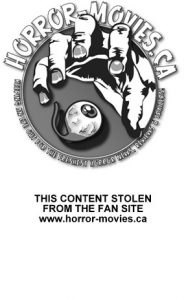
![Best Indie Horror Films [ Part 2 ]](https://www.horror-movies.ca/wp-content/uploads/2021/04/absentia-610x343-2-300x169.jpg)
